Cryptocurrency: Global Regulations, Properties, and Analysis
VerifiedAdded on 2022/08/14
|20
|4818
|109
Project
AI Summary
This project proposal provides a detailed analysis of cryptocurrencies, beginning with a background on their emergence and evolution, with a specific focus on Bitcoin. The project delves into the properties of cryptocurrencies, including their global and fast transactions, security, and permissionless nature. It also examines key terms associated with cryptocurrencies such as addresses, altcoins, arbitrage, and blockchain technology. The analysis further explores the monetary properties of cryptocurrencies, including their controlled supply and lack of debt representation. The proposal highlights critical issues like the double-spending problem and the Byzantine Generals Problem, which are central to the security and functionality of cryptocurrencies. It also discusses mining processes, blockchain technology, and ethical considerations. The project outlines the research objectives, questions, design, data collection, and analysis methods, along with a timeline and ethical considerations. The conclusion summarizes the key aspects of the cryptocurrency landscape, providing a comprehensive overview of the subject.
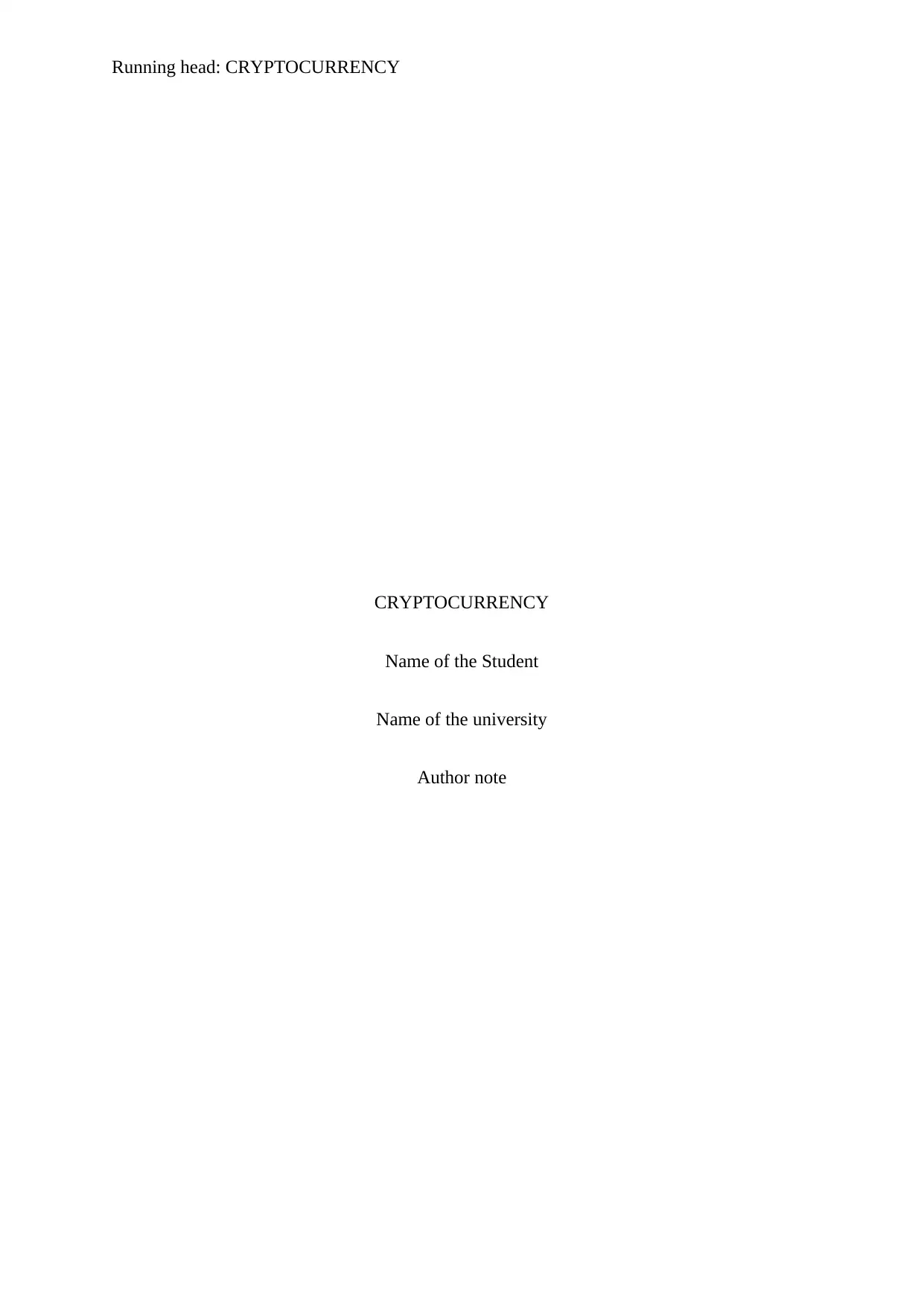
Running head: CRYPTOCURRENCY
CRYPTOCURRENCY
Name of the Student
Name of the university
Author note
CRYPTOCURRENCY
Name of the Student
Name of the university
Author note
Paraphrase This Document
Need a fresh take? Get an instant paraphrase of this document with our AI Paraphraser
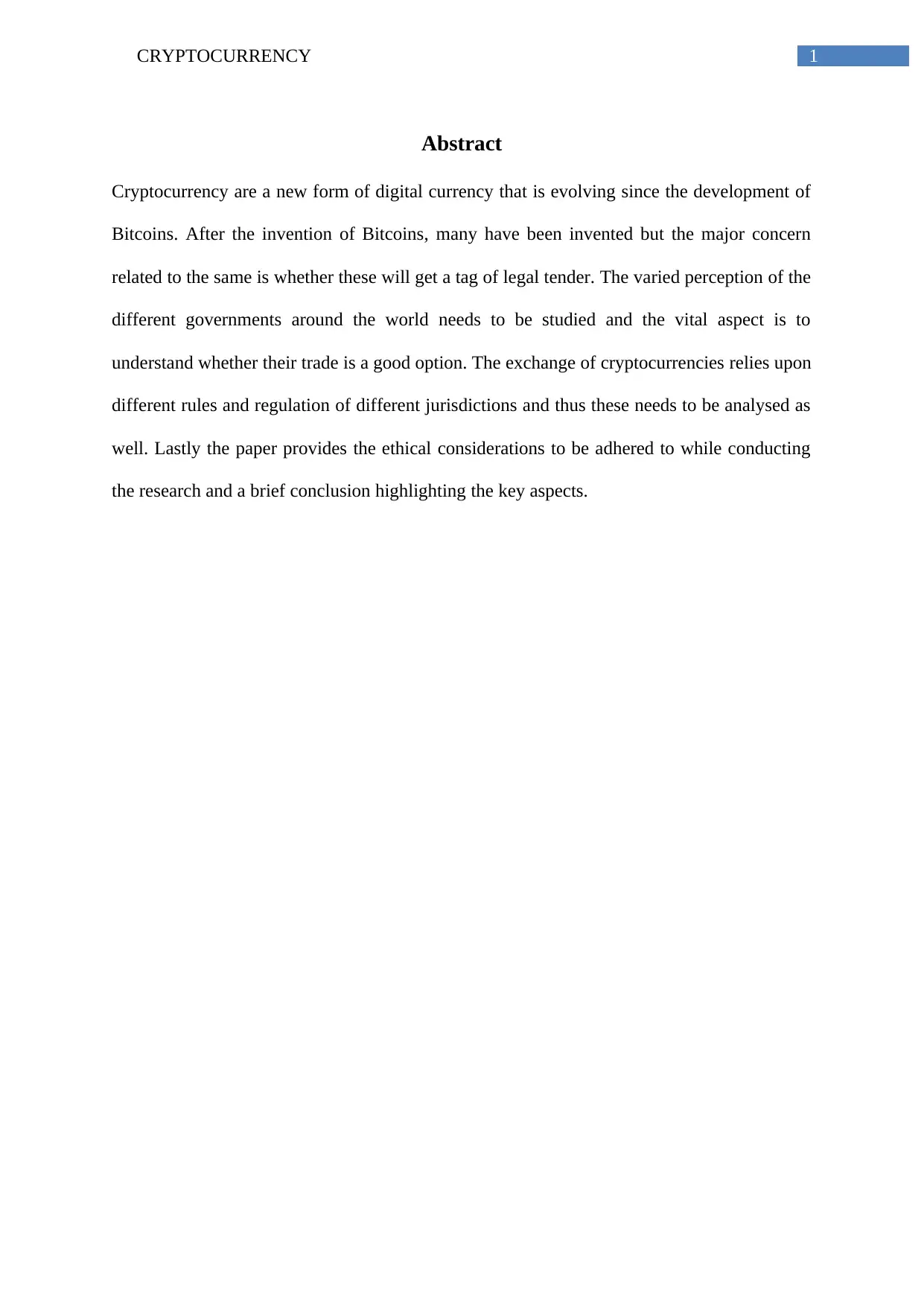
1CRYPTOCURRENCY
Abstract
Cryptocurrency are a new form of digital currency that is evolving since the development of
Bitcoins. After the invention of Bitcoins, many have been invented but the major concern
related to the same is whether these will get a tag of legal tender. The varied perception of the
different governments around the world needs to be studied and the vital aspect is to
understand whether their trade is a good option. The exchange of cryptocurrencies relies upon
different rules and regulation of different jurisdictions and thus these needs to be analysed as
well. Lastly the paper provides the ethical considerations to be adhered to while conducting
the research and a brief conclusion highlighting the key aspects.
Abstract
Cryptocurrency are a new form of digital currency that is evolving since the development of
Bitcoins. After the invention of Bitcoins, many have been invented but the major concern
related to the same is whether these will get a tag of legal tender. The varied perception of the
different governments around the world needs to be studied and the vital aspect is to
understand whether their trade is a good option. The exchange of cryptocurrencies relies upon
different rules and regulation of different jurisdictions and thus these needs to be analysed as
well. Lastly the paper provides the ethical considerations to be adhered to while conducting
the research and a brief conclusion highlighting the key aspects.
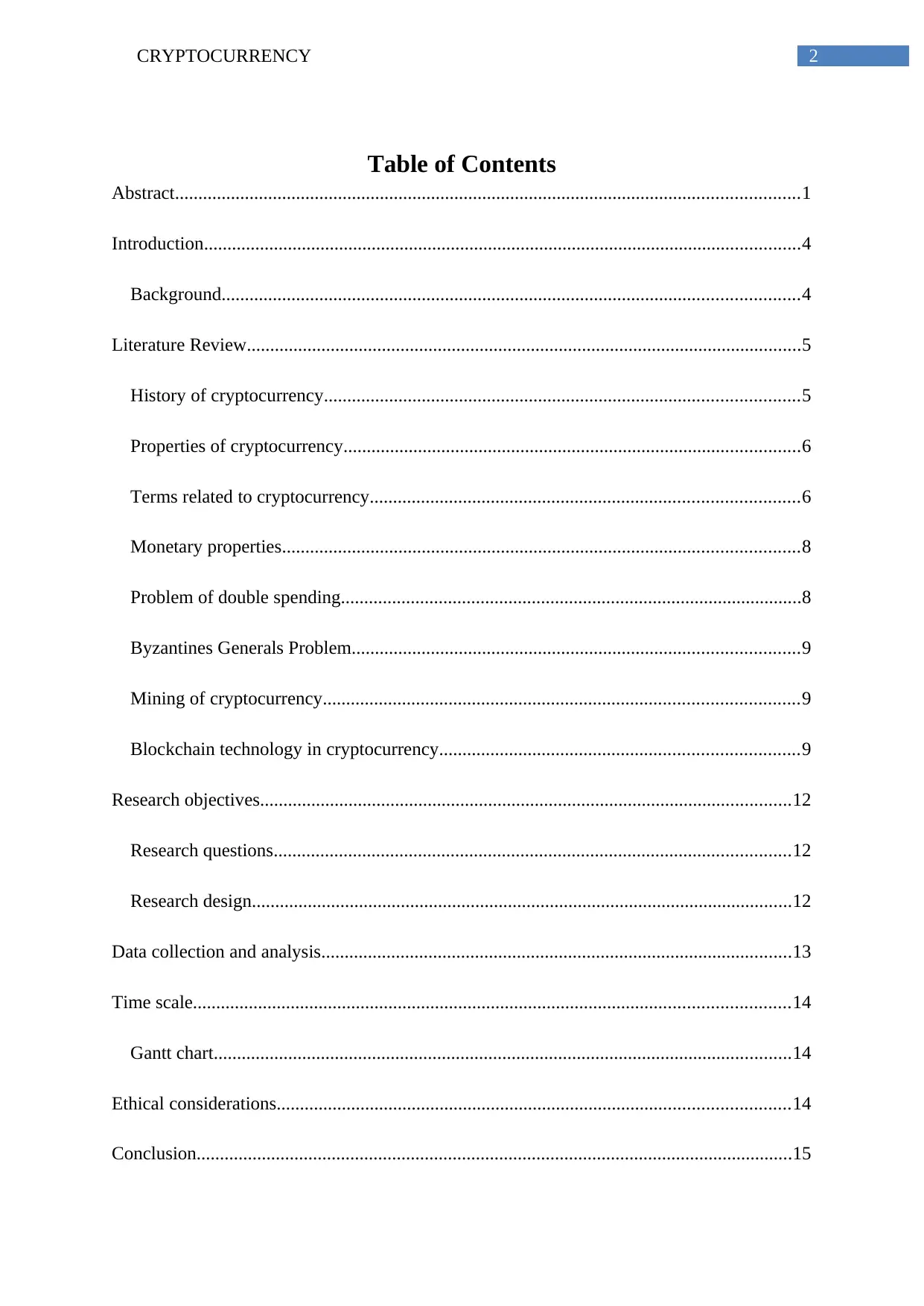
2CRYPTOCURRENCY
Table of Contents
Abstract......................................................................................................................................1
Introduction................................................................................................................................4
Background............................................................................................................................4
Literature Review.......................................................................................................................5
History of cryptocurrency......................................................................................................5
Properties of cryptocurrency..................................................................................................6
Terms related to cryptocurrency............................................................................................6
Monetary properties...............................................................................................................8
Problem of double spending...................................................................................................8
Byzantines Generals Problem................................................................................................9
Mining of cryptocurrency......................................................................................................9
Blockchain technology in cryptocurrency.............................................................................9
Research objectives..................................................................................................................12
Research questions...............................................................................................................12
Research design....................................................................................................................12
Data collection and analysis.....................................................................................................13
Time scale................................................................................................................................14
Gantt chart............................................................................................................................14
Ethical considerations..............................................................................................................14
Conclusion................................................................................................................................15
Table of Contents
Abstract......................................................................................................................................1
Introduction................................................................................................................................4
Background............................................................................................................................4
Literature Review.......................................................................................................................5
History of cryptocurrency......................................................................................................5
Properties of cryptocurrency..................................................................................................6
Terms related to cryptocurrency............................................................................................6
Monetary properties...............................................................................................................8
Problem of double spending...................................................................................................8
Byzantines Generals Problem................................................................................................9
Mining of cryptocurrency......................................................................................................9
Blockchain technology in cryptocurrency.............................................................................9
Research objectives..................................................................................................................12
Research questions...............................................................................................................12
Research design....................................................................................................................12
Data collection and analysis.....................................................................................................13
Time scale................................................................................................................................14
Gantt chart............................................................................................................................14
Ethical considerations..............................................................................................................14
Conclusion................................................................................................................................15
⊘ This is a preview!⊘
Do you want full access?
Subscribe today to unlock all pages.

Trusted by 1+ million students worldwide

3CRYPTOCURRENCY
References................................................................................................................................17
References................................................................................................................................17
Paraphrase This Document
Need a fresh take? Get an instant paraphrase of this document with our AI Paraphraser
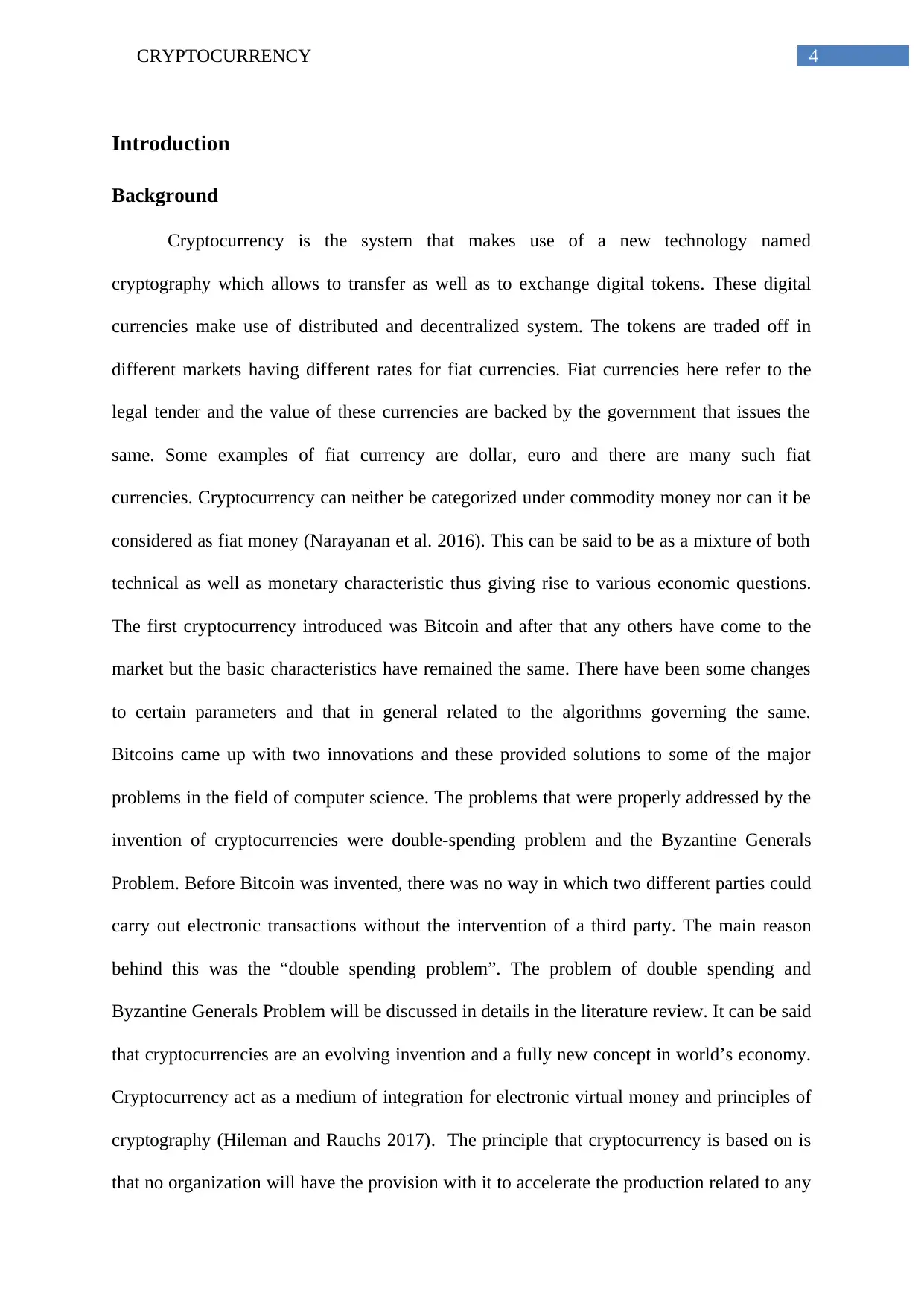
4CRYPTOCURRENCY
Introduction
Background
Cryptocurrency is the system that makes use of a new technology named
cryptography which allows to transfer as well as to exchange digital tokens. These digital
currencies make use of distributed and decentralized system. The tokens are traded off in
different markets having different rates for fiat currencies. Fiat currencies here refer to the
legal tender and the value of these currencies are backed by the government that issues the
same. Some examples of fiat currency are dollar, euro and there are many such fiat
currencies. Cryptocurrency can neither be categorized under commodity money nor can it be
considered as fiat money (Narayanan et al. 2016). This can be said to be as a mixture of both
technical as well as monetary characteristic thus giving rise to various economic questions.
The first cryptocurrency introduced was Bitcoin and after that any others have come to the
market but the basic characteristics have remained the same. There have been some changes
to certain parameters and that in general related to the algorithms governing the same.
Bitcoins came up with two innovations and these provided solutions to some of the major
problems in the field of computer science. The problems that were properly addressed by the
invention of cryptocurrencies were double-spending problem and the Byzantine Generals
Problem. Before Bitcoin was invented, there was no way in which two different parties could
carry out electronic transactions without the intervention of a third party. The main reason
behind this was the “double spending problem”. The problem of double spending and
Byzantine Generals Problem will be discussed in details in the literature review. It can be said
that cryptocurrencies are an evolving invention and a fully new concept in world’s economy.
Cryptocurrency act as a medium of integration for electronic virtual money and principles of
cryptography (Hileman and Rauchs 2017). The principle that cryptocurrency is based on is
that no organization will have the provision with it to accelerate the production related to any
Introduction
Background
Cryptocurrency is the system that makes use of a new technology named
cryptography which allows to transfer as well as to exchange digital tokens. These digital
currencies make use of distributed and decentralized system. The tokens are traded off in
different markets having different rates for fiat currencies. Fiat currencies here refer to the
legal tender and the value of these currencies are backed by the government that issues the
same. Some examples of fiat currency are dollar, euro and there are many such fiat
currencies. Cryptocurrency can neither be categorized under commodity money nor can it be
considered as fiat money (Narayanan et al. 2016). This can be said to be as a mixture of both
technical as well as monetary characteristic thus giving rise to various economic questions.
The first cryptocurrency introduced was Bitcoin and after that any others have come to the
market but the basic characteristics have remained the same. There have been some changes
to certain parameters and that in general related to the algorithms governing the same.
Bitcoins came up with two innovations and these provided solutions to some of the major
problems in the field of computer science. The problems that were properly addressed by the
invention of cryptocurrencies were double-spending problem and the Byzantine Generals
Problem. Before Bitcoin was invented, there was no way in which two different parties could
carry out electronic transactions without the intervention of a third party. The main reason
behind this was the “double spending problem”. The problem of double spending and
Byzantine Generals Problem will be discussed in details in the literature review. It can be said
that cryptocurrencies are an evolving invention and a fully new concept in world’s economy.
Cryptocurrency act as a medium of integration for electronic virtual money and principles of
cryptography (Hileman and Rauchs 2017). The principle that cryptocurrency is based on is
that no organization will have the provision with it to accelerate the production related to any
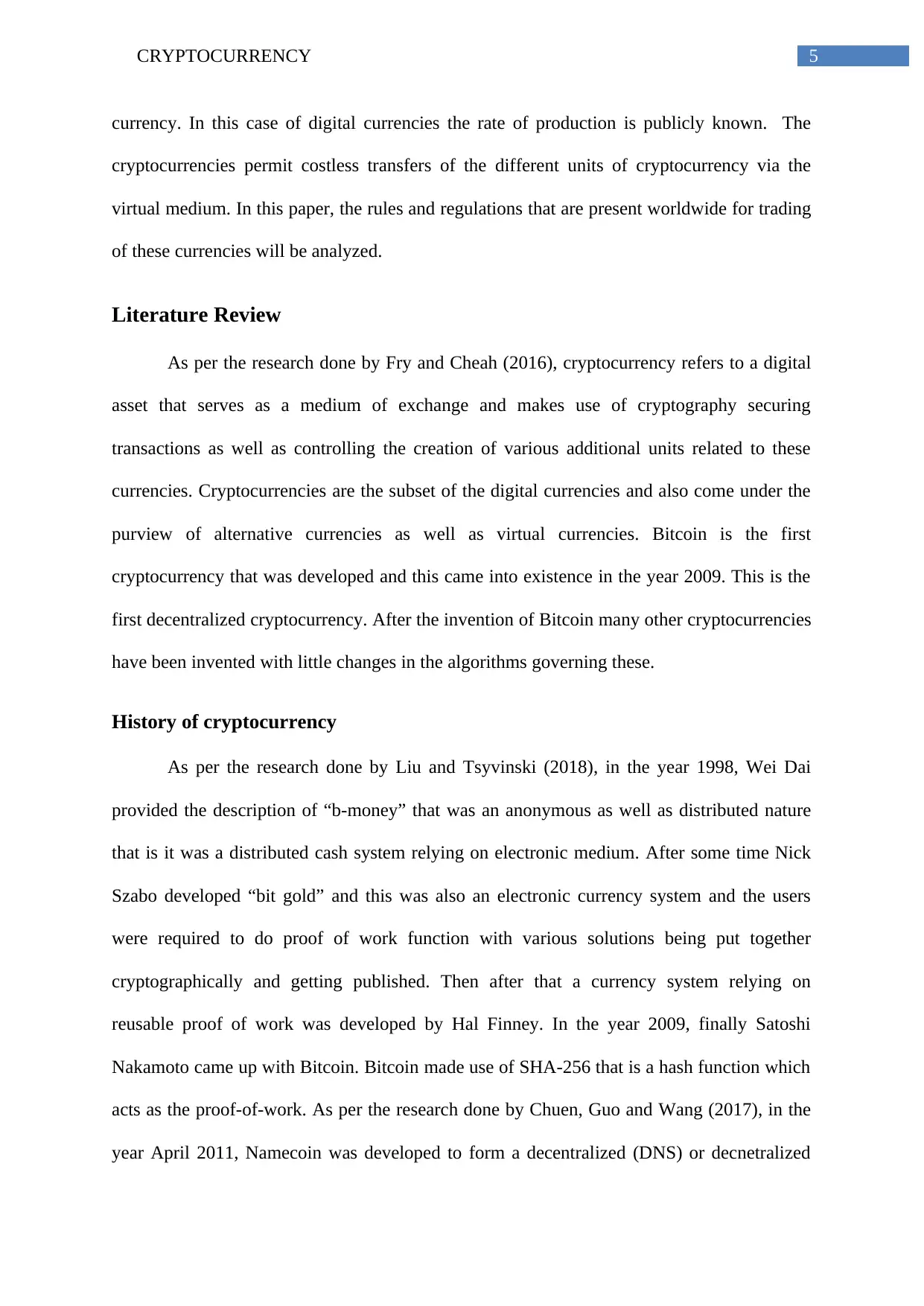
5CRYPTOCURRENCY
currency. In this case of digital currencies the rate of production is publicly known. The
cryptocurrencies permit costless transfers of the different units of cryptocurrency via the
virtual medium. In this paper, the rules and regulations that are present worldwide for trading
of these currencies will be analyzed.
Literature Review
As per the research done by Fry and Cheah (2016), cryptocurrency refers to a digital
asset that serves as a medium of exchange and makes use of cryptography securing
transactions as well as controlling the creation of various additional units related to these
currencies. Cryptocurrencies are the subset of the digital currencies and also come under the
purview of alternative currencies as well as virtual currencies. Bitcoin is the first
cryptocurrency that was developed and this came into existence in the year 2009. This is the
first decentralized cryptocurrency. After the invention of Bitcoin many other cryptocurrencies
have been invented with little changes in the algorithms governing these.
History of cryptocurrency
As per the research done by Liu and Tsyvinski (2018), in the year 1998, Wei Dai
provided the description of “b-money” that was an anonymous as well as distributed nature
that is it was a distributed cash system relying on electronic medium. After some time Nick
Szabo developed “bit gold” and this was also an electronic currency system and the users
were required to do proof of work function with various solutions being put together
cryptographically and getting published. Then after that a currency system relying on
reusable proof of work was developed by Hal Finney. In the year 2009, finally Satoshi
Nakamoto came up with Bitcoin. Bitcoin made use of SHA-256 that is a hash function which
acts as the proof-of-work. As per the research done by Chuen, Guo and Wang (2017), in the
year April 2011, Namecoin was developed to form a decentralized (DNS) or decnetralized
currency. In this case of digital currencies the rate of production is publicly known. The
cryptocurrencies permit costless transfers of the different units of cryptocurrency via the
virtual medium. In this paper, the rules and regulations that are present worldwide for trading
of these currencies will be analyzed.
Literature Review
As per the research done by Fry and Cheah (2016), cryptocurrency refers to a digital
asset that serves as a medium of exchange and makes use of cryptography securing
transactions as well as controlling the creation of various additional units related to these
currencies. Cryptocurrencies are the subset of the digital currencies and also come under the
purview of alternative currencies as well as virtual currencies. Bitcoin is the first
cryptocurrency that was developed and this came into existence in the year 2009. This is the
first decentralized cryptocurrency. After the invention of Bitcoin many other cryptocurrencies
have been invented with little changes in the algorithms governing these.
History of cryptocurrency
As per the research done by Liu and Tsyvinski (2018), in the year 1998, Wei Dai
provided the description of “b-money” that was an anonymous as well as distributed nature
that is it was a distributed cash system relying on electronic medium. After some time Nick
Szabo developed “bit gold” and this was also an electronic currency system and the users
were required to do proof of work function with various solutions being put together
cryptographically and getting published. Then after that a currency system relying on
reusable proof of work was developed by Hal Finney. In the year 2009, finally Satoshi
Nakamoto came up with Bitcoin. Bitcoin made use of SHA-256 that is a hash function which
acts as the proof-of-work. As per the research done by Chuen, Guo and Wang (2017), in the
year April 2011, Namecoin was developed to form a decentralized (DNS) or decnetralized
⊘ This is a preview!⊘
Do you want full access?
Subscribe today to unlock all pages.

Trusted by 1+ million students worldwide
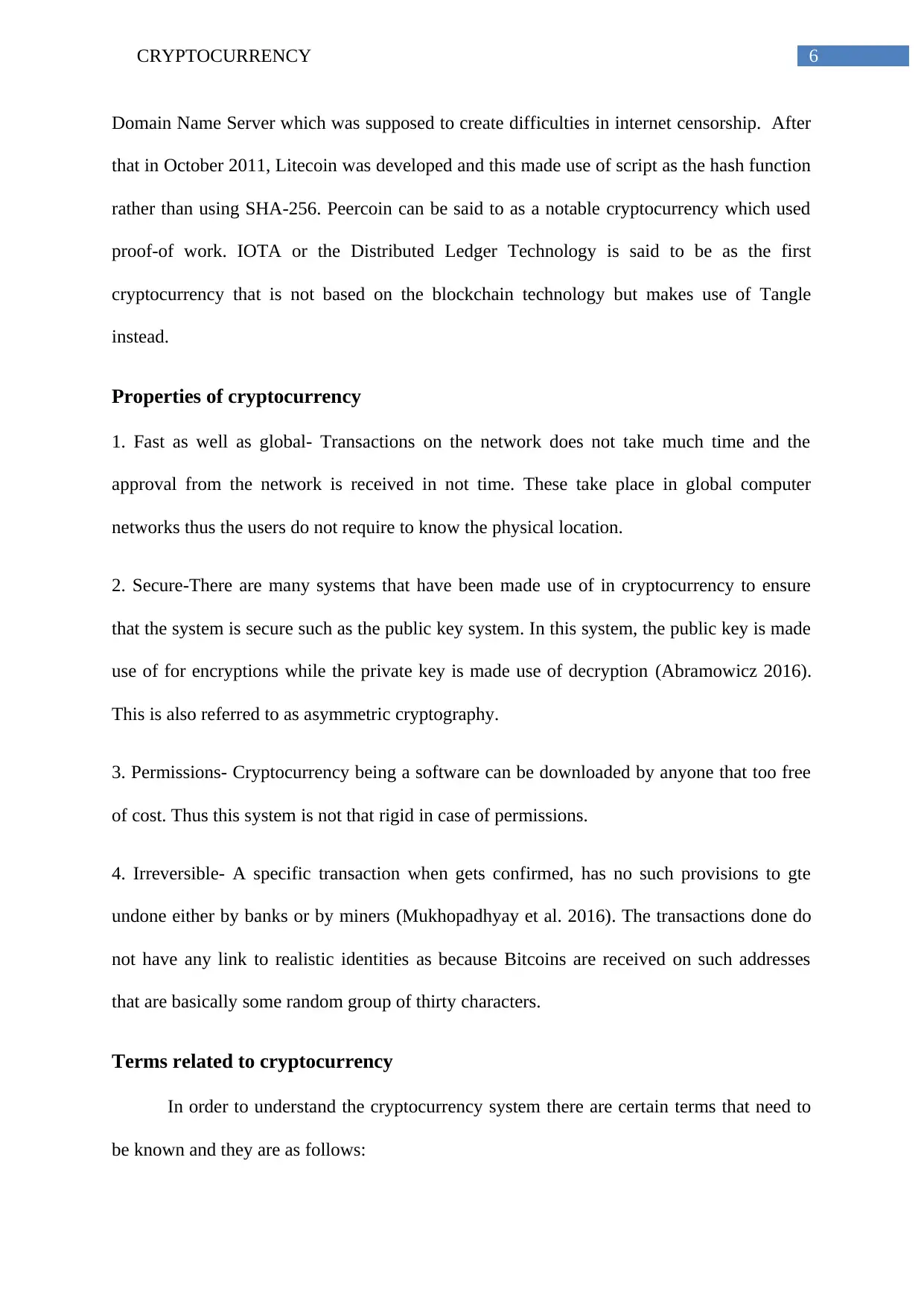
6CRYPTOCURRENCY
Domain Name Server which was supposed to create difficulties in internet censorship. After
that in October 2011, Litecoin was developed and this made use of script as the hash function
rather than using SHA-256. Peercoin can be said to as a notable cryptocurrency which used
proof-of work. IOTA or the Distributed Ledger Technology is said to be as the first
cryptocurrency that is not based on the blockchain technology but makes use of Tangle
instead.
Properties of cryptocurrency
1. Fast as well as global- Transactions on the network does not take much time and the
approval from the network is received in not time. These take place in global computer
networks thus the users do not require to know the physical location.
2. Secure-There are many systems that have been made use of in cryptocurrency to ensure
that the system is secure such as the public key system. In this system, the public key is made
use of for encryptions while the private key is made use of decryption (Abramowicz 2016).
This is also referred to as asymmetric cryptography.
3. Permissions- Cryptocurrency being a software can be downloaded by anyone that too free
of cost. Thus this system is not that rigid in case of permissions.
4. Irreversible- A specific transaction when gets confirmed, has no such provisions to gte
undone either by banks or by miners (Mukhopadhyay et al. 2016). The transactions done do
not have any link to realistic identities as because Bitcoins are received on such addresses
that are basically some random group of thirty characters.
Terms related to cryptocurrency
In order to understand the cryptocurrency system there are certain terms that need to
be known and they are as follows:
Domain Name Server which was supposed to create difficulties in internet censorship. After
that in October 2011, Litecoin was developed and this made use of script as the hash function
rather than using SHA-256. Peercoin can be said to as a notable cryptocurrency which used
proof-of work. IOTA or the Distributed Ledger Technology is said to be as the first
cryptocurrency that is not based on the blockchain technology but makes use of Tangle
instead.
Properties of cryptocurrency
1. Fast as well as global- Transactions on the network does not take much time and the
approval from the network is received in not time. These take place in global computer
networks thus the users do not require to know the physical location.
2. Secure-There are many systems that have been made use of in cryptocurrency to ensure
that the system is secure such as the public key system. In this system, the public key is made
use of for encryptions while the private key is made use of decryption (Abramowicz 2016).
This is also referred to as asymmetric cryptography.
3. Permissions- Cryptocurrency being a software can be downloaded by anyone that too free
of cost. Thus this system is not that rigid in case of permissions.
4. Irreversible- A specific transaction when gets confirmed, has no such provisions to gte
undone either by banks or by miners (Mukhopadhyay et al. 2016). The transactions done do
not have any link to realistic identities as because Bitcoins are received on such addresses
that are basically some random group of thirty characters.
Terms related to cryptocurrency
In order to understand the cryptocurrency system there are certain terms that need to
be known and they are as follows:
Paraphrase This Document
Need a fresh take? Get an instant paraphrase of this document with our AI Paraphraser
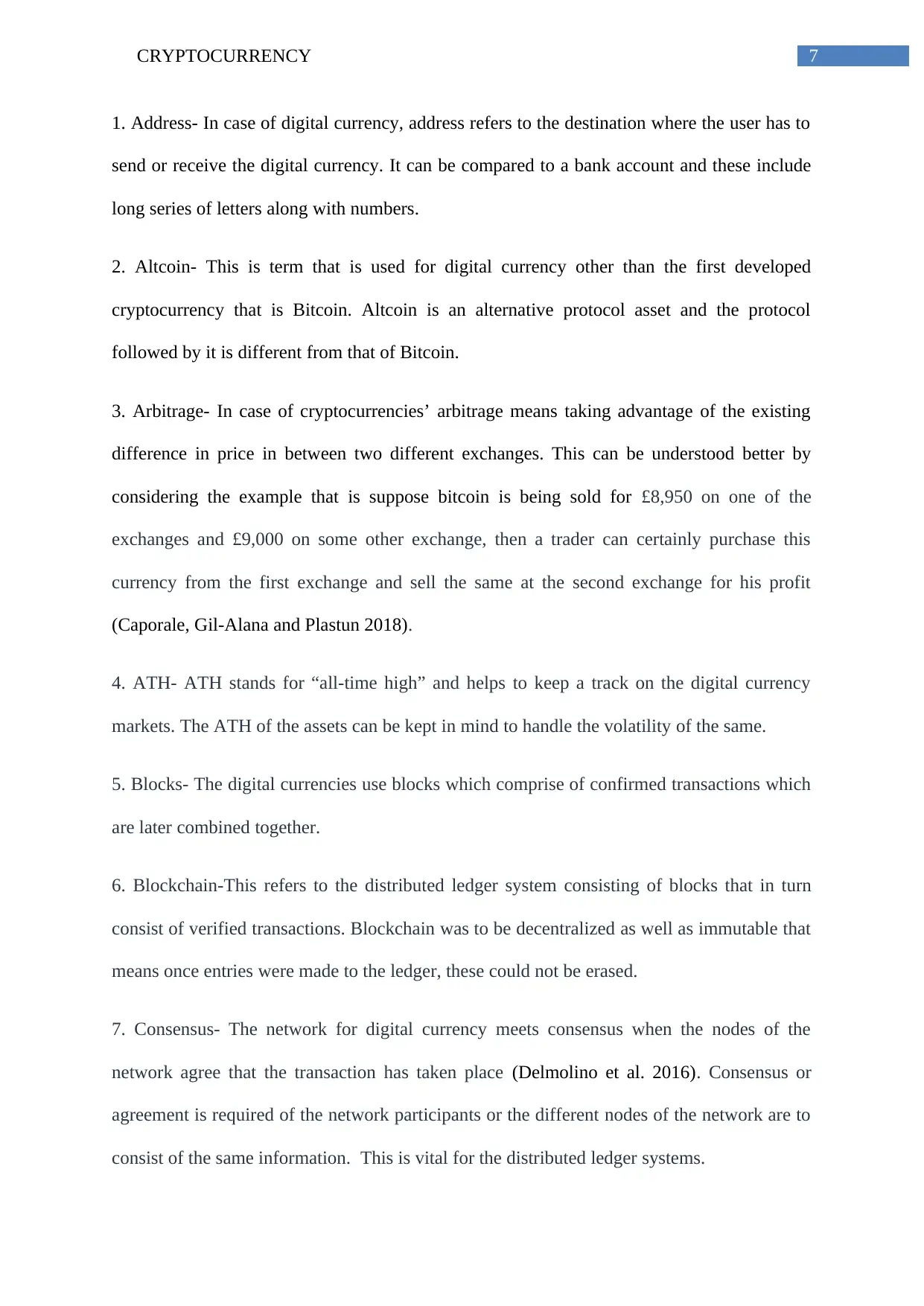
7CRYPTOCURRENCY
1. Address- In case of digital currency, address refers to the destination where the user has to
send or receive the digital currency. It can be compared to a bank account and these include
long series of letters along with numbers.
2. Altcoin- This is term that is used for digital currency other than the first developed
cryptocurrency that is Bitcoin. Altcoin is an alternative protocol asset and the protocol
followed by it is different from that of Bitcoin.
3. Arbitrage- In case of cryptocurrencies’ arbitrage means taking advantage of the existing
difference in price in between two different exchanges. This can be understood better by
considering the example that is suppose bitcoin is being sold for £8,950 on one of the
exchanges and £9,000 on some other exchange, then a trader can certainly purchase this
currency from the first exchange and sell the same at the second exchange for his profit
(Caporale, Gil-Alana and Plastun 2018).
4. ATH- ATH stands for “all-time high” and helps to keep a track on the digital currency
markets. The ATH of the assets can be kept in mind to handle the volatility of the same.
5. Blocks- The digital currencies use blocks which comprise of confirmed transactions which
are later combined together.
6. Blockchain-This refers to the distributed ledger system consisting of blocks that in turn
consist of verified transactions. Blockchain was to be decentralized as well as immutable that
means once entries were made to the ledger, these could not be erased.
7. Consensus- The network for digital currency meets consensus when the nodes of the
network agree that the transaction has taken place (Delmolino et al. 2016). Consensus or
agreement is required of the network participants or the different nodes of the network are to
consist of the same information. This is vital for the distributed ledger systems.
1. Address- In case of digital currency, address refers to the destination where the user has to
send or receive the digital currency. It can be compared to a bank account and these include
long series of letters along with numbers.
2. Altcoin- This is term that is used for digital currency other than the first developed
cryptocurrency that is Bitcoin. Altcoin is an alternative protocol asset and the protocol
followed by it is different from that of Bitcoin.
3. Arbitrage- In case of cryptocurrencies’ arbitrage means taking advantage of the existing
difference in price in between two different exchanges. This can be understood better by
considering the example that is suppose bitcoin is being sold for £8,950 on one of the
exchanges and £9,000 on some other exchange, then a trader can certainly purchase this
currency from the first exchange and sell the same at the second exchange for his profit
(Caporale, Gil-Alana and Plastun 2018).
4. ATH- ATH stands for “all-time high” and helps to keep a track on the digital currency
markets. The ATH of the assets can be kept in mind to handle the volatility of the same.
5. Blocks- The digital currencies use blocks which comprise of confirmed transactions which
are later combined together.
6. Blockchain-This refers to the distributed ledger system consisting of blocks that in turn
consist of verified transactions. Blockchain was to be decentralized as well as immutable that
means once entries were made to the ledger, these could not be erased.
7. Consensus- The network for digital currency meets consensus when the nodes of the
network agree that the transaction has taken place (Delmolino et al. 2016). Consensus or
agreement is required of the network participants or the different nodes of the network are to
consist of the same information. This is vital for the distributed ledger systems.
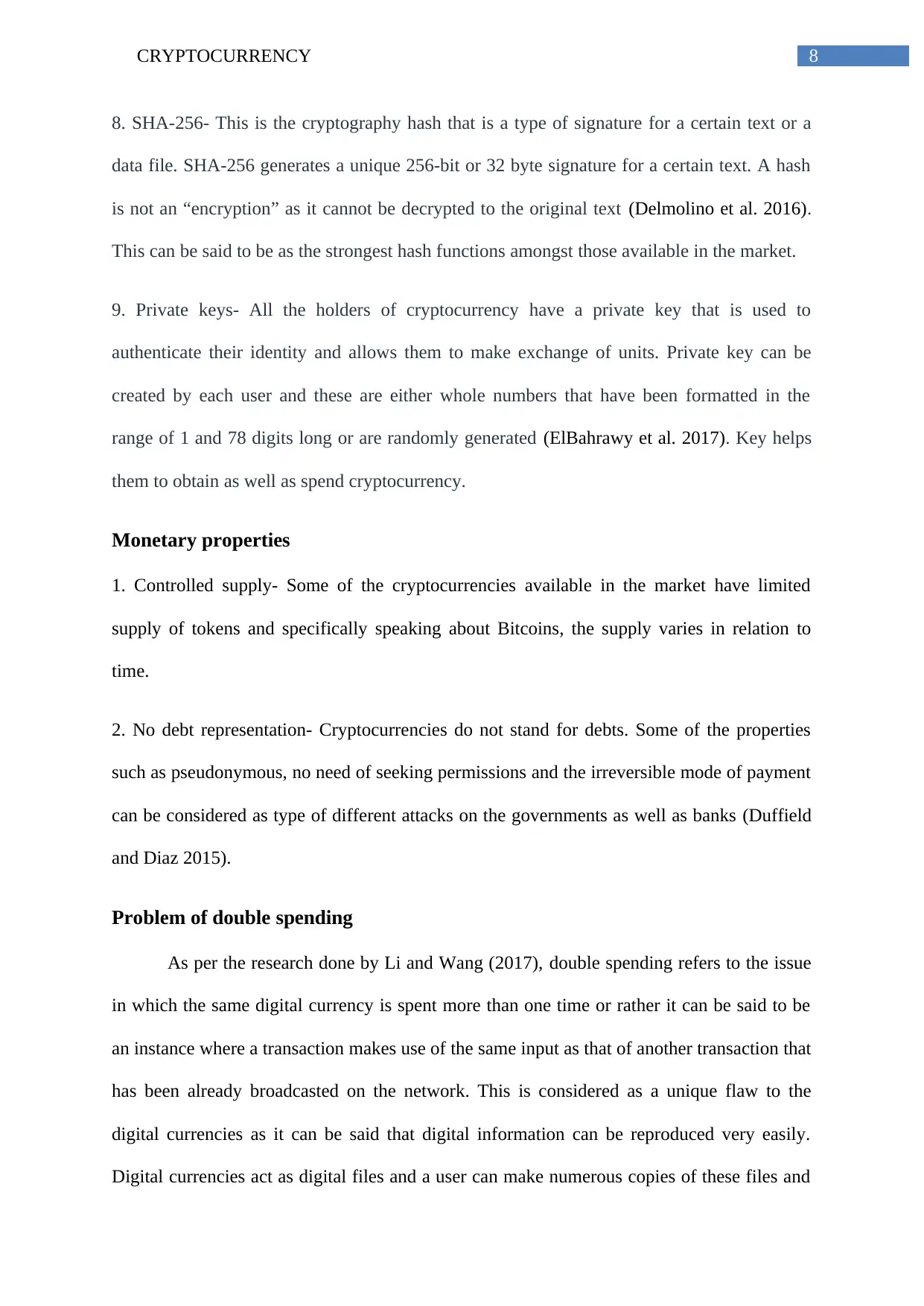
8CRYPTOCURRENCY
8. SHA-256- This is the cryptography hash that is a type of signature for a certain text or a
data file. SHA-256 generates a unique 256-bit or 32 byte signature for a certain text. A hash
is not an “encryption” as it cannot be decrypted to the original text (Delmolino et al. 2016).
This can be said to be as the strongest hash functions amongst those available in the market.
9. Private keys- All the holders of cryptocurrency have a private key that is used to
authenticate their identity and allows them to make exchange of units. Private key can be
created by each user and these are either whole numbers that have been formatted in the
range of 1 and 78 digits long or are randomly generated (ElBahrawy et al. 2017). Key helps
them to obtain as well as spend cryptocurrency.
Monetary properties
1. Controlled supply- Some of the cryptocurrencies available in the market have limited
supply of tokens and specifically speaking about Bitcoins, the supply varies in relation to
time.
2. No debt representation- Cryptocurrencies do not stand for debts. Some of the properties
such as pseudonymous, no need of seeking permissions and the irreversible mode of payment
can be considered as type of different attacks on the governments as well as banks (Duffield
and Diaz 2015).
Problem of double spending
As per the research done by Li and Wang (2017), double spending refers to the issue
in which the same digital currency is spent more than one time or rather it can be said to be
an instance where a transaction makes use of the same input as that of another transaction that
has been already broadcasted on the network. This is considered as a unique flaw to the
digital currencies as it can be said that digital information can be reproduced very easily.
Digital currencies act as digital files and a user can make numerous copies of these files and
8. SHA-256- This is the cryptography hash that is a type of signature for a certain text or a
data file. SHA-256 generates a unique 256-bit or 32 byte signature for a certain text. A hash
is not an “encryption” as it cannot be decrypted to the original text (Delmolino et al. 2016).
This can be said to be as the strongest hash functions amongst those available in the market.
9. Private keys- All the holders of cryptocurrency have a private key that is used to
authenticate their identity and allows them to make exchange of units. Private key can be
created by each user and these are either whole numbers that have been formatted in the
range of 1 and 78 digits long or are randomly generated (ElBahrawy et al. 2017). Key helps
them to obtain as well as spend cryptocurrency.
Monetary properties
1. Controlled supply- Some of the cryptocurrencies available in the market have limited
supply of tokens and specifically speaking about Bitcoins, the supply varies in relation to
time.
2. No debt representation- Cryptocurrencies do not stand for debts. Some of the properties
such as pseudonymous, no need of seeking permissions and the irreversible mode of payment
can be considered as type of different attacks on the governments as well as banks (Duffield
and Diaz 2015).
Problem of double spending
As per the research done by Li and Wang (2017), double spending refers to the issue
in which the same digital currency is spent more than one time or rather it can be said to be
an instance where a transaction makes use of the same input as that of another transaction that
has been already broadcasted on the network. This is considered as a unique flaw to the
digital currencies as it can be said that digital information can be reproduced very easily.
Digital currencies act as digital files and a user can make numerous copies of these files and
⊘ This is a preview!⊘
Do you want full access?
Subscribe today to unlock all pages.

Trusted by 1+ million students worldwide
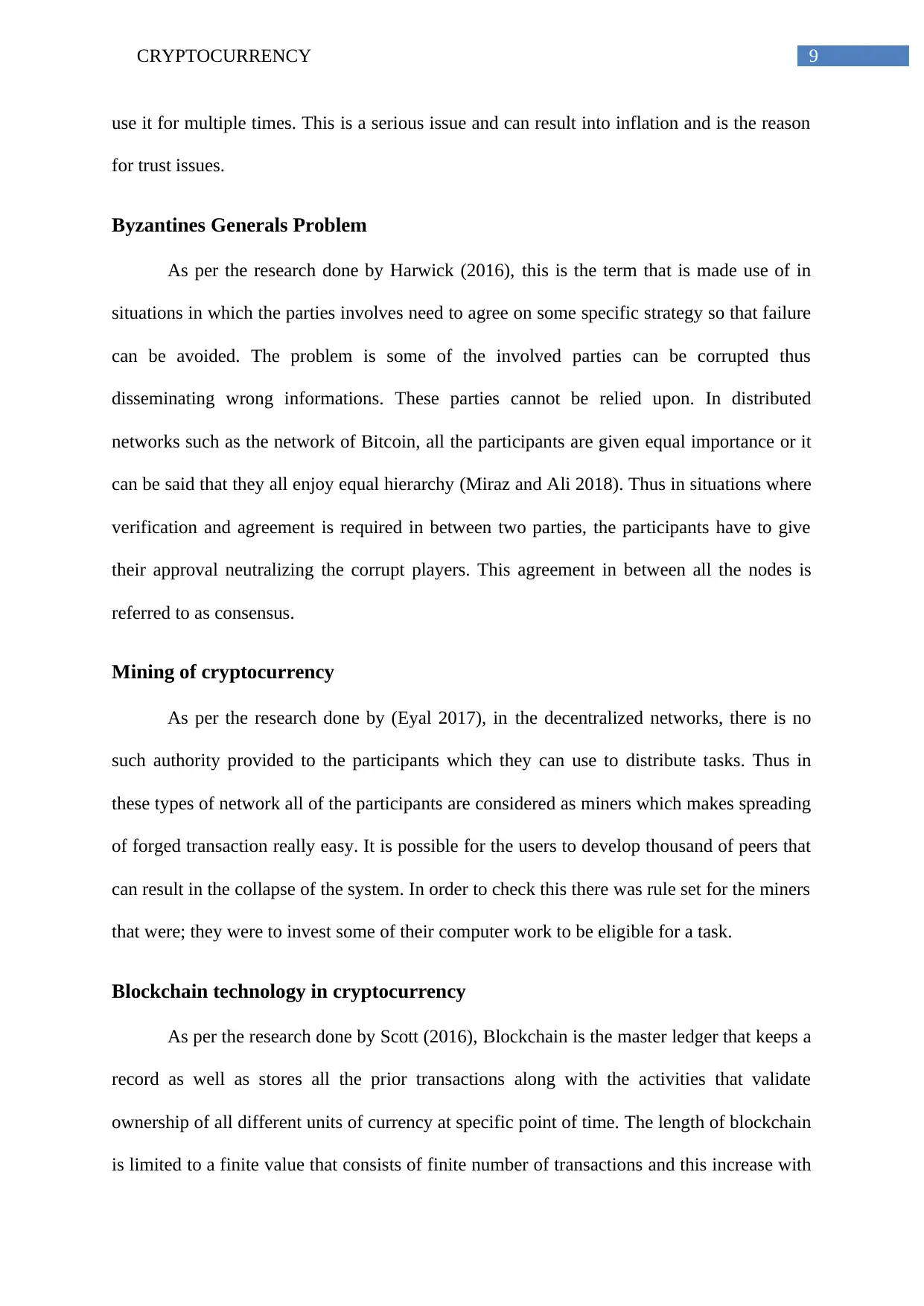
9CRYPTOCURRENCY
use it for multiple times. This is a serious issue and can result into inflation and is the reason
for trust issues.
Byzantines Generals Problem
As per the research done by Harwick (2016), this is the term that is made use of in
situations in which the parties involves need to agree on some specific strategy so that failure
can be avoided. The problem is some of the involved parties can be corrupted thus
disseminating wrong informations. These parties cannot be relied upon. In distributed
networks such as the network of Bitcoin, all the participants are given equal importance or it
can be said that they all enjoy equal hierarchy (Miraz and Ali 2018). Thus in situations where
verification and agreement is required in between two parties, the participants have to give
their approval neutralizing the corrupt players. This agreement in between all the nodes is
referred to as consensus.
Mining of cryptocurrency
As per the research done by (Eyal 2017), in the decentralized networks, there is no
such authority provided to the participants which they can use to distribute tasks. Thus in
these types of network all of the participants are considered as miners which makes spreading
of forged transaction really easy. It is possible for the users to develop thousand of peers that
can result in the collapse of the system. In order to check this there was rule set for the miners
that were; they were to invest some of their computer work to be eligible for a task.
Blockchain technology in cryptocurrency
As per the research done by Scott (2016), Blockchain is the master ledger that keeps a
record as well as stores all the prior transactions along with the activities that validate
ownership of all different units of currency at specific point of time. The length of blockchain
is limited to a finite value that consists of finite number of transactions and this increase with
use it for multiple times. This is a serious issue and can result into inflation and is the reason
for trust issues.
Byzantines Generals Problem
As per the research done by Harwick (2016), this is the term that is made use of in
situations in which the parties involves need to agree on some specific strategy so that failure
can be avoided. The problem is some of the involved parties can be corrupted thus
disseminating wrong informations. These parties cannot be relied upon. In distributed
networks such as the network of Bitcoin, all the participants are given equal importance or it
can be said that they all enjoy equal hierarchy (Miraz and Ali 2018). Thus in situations where
verification and agreement is required in between two parties, the participants have to give
their approval neutralizing the corrupt players. This agreement in between all the nodes is
referred to as consensus.
Mining of cryptocurrency
As per the research done by (Eyal 2017), in the decentralized networks, there is no
such authority provided to the participants which they can use to distribute tasks. Thus in
these types of network all of the participants are considered as miners which makes spreading
of forged transaction really easy. It is possible for the users to develop thousand of peers that
can result in the collapse of the system. In order to check this there was rule set for the miners
that were; they were to invest some of their computer work to be eligible for a task.
Blockchain technology in cryptocurrency
As per the research done by Scott (2016), Blockchain is the master ledger that keeps a
record as well as stores all the prior transactions along with the activities that validate
ownership of all different units of currency at specific point of time. The length of blockchain
is limited to a finite value that consists of finite number of transactions and this increase with
Paraphrase This Document
Need a fresh take? Get an instant paraphrase of this document with our AI Paraphraser
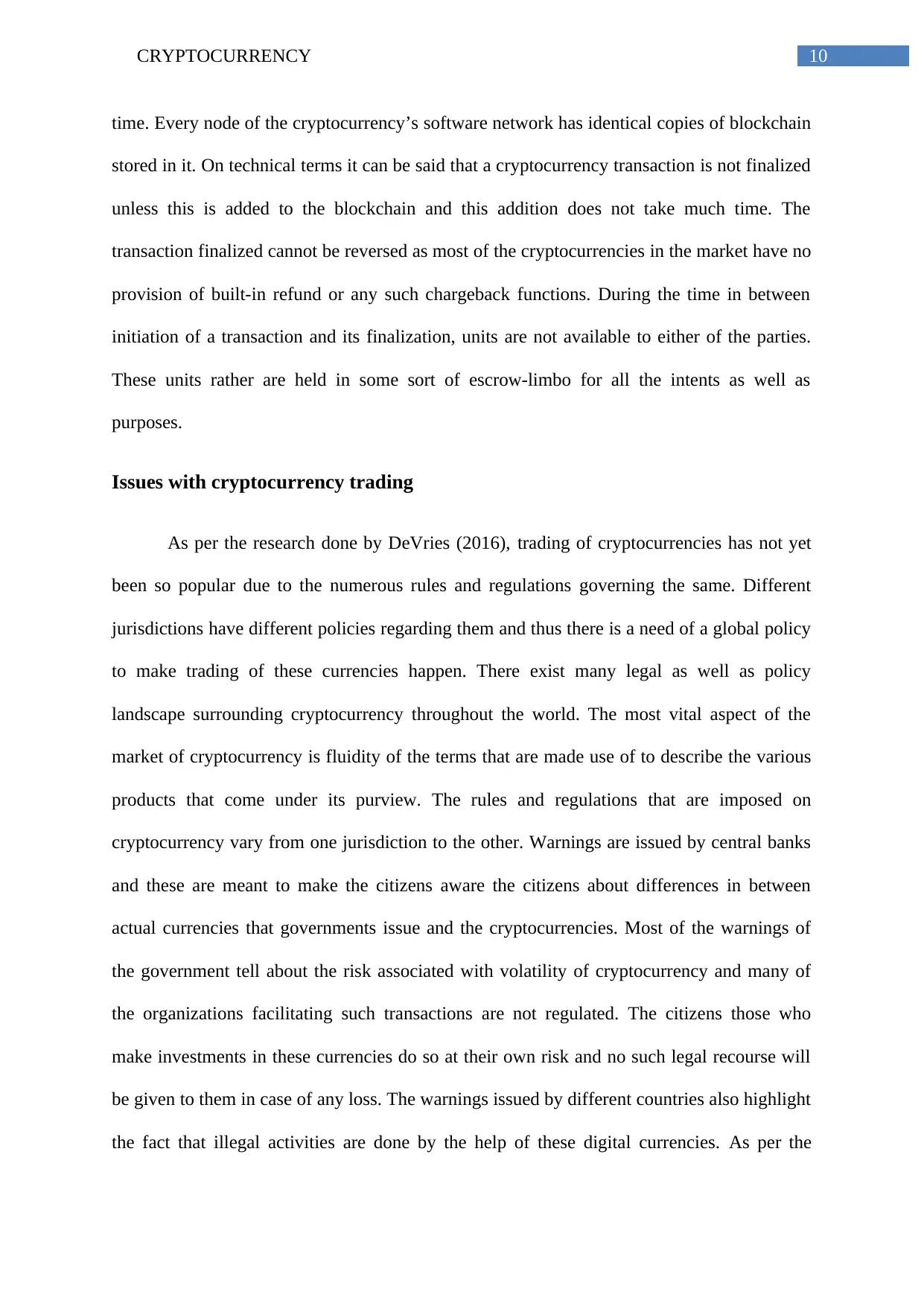
10CRYPTOCURRENCY
time. Every node of the cryptocurrency’s software network has identical copies of blockchain
stored in it. On technical terms it can be said that a cryptocurrency transaction is not finalized
unless this is added to the blockchain and this addition does not take much time. The
transaction finalized cannot be reversed as most of the cryptocurrencies in the market have no
provision of built-in refund or any such chargeback functions. During the time in between
initiation of a transaction and its finalization, units are not available to either of the parties.
These units rather are held in some sort of escrow-limbo for all the intents as well as
purposes.
Issues with cryptocurrency trading
As per the research done by DeVries (2016), trading of cryptocurrencies has not yet
been so popular due to the numerous rules and regulations governing the same. Different
jurisdictions have different policies regarding them and thus there is a need of a global policy
to make trading of these currencies happen. There exist many legal as well as policy
landscape surrounding cryptocurrency throughout the world. The most vital aspect of the
market of cryptocurrency is fluidity of the terms that are made use of to describe the various
products that come under its purview. The rules and regulations that are imposed on
cryptocurrency vary from one jurisdiction to the other. Warnings are issued by central banks
and these are meant to make the citizens aware the citizens about differences in between
actual currencies that governments issue and the cryptocurrencies. Most of the warnings of
the government tell about the risk associated with volatility of cryptocurrency and many of
the organizations facilitating such transactions are not regulated. The citizens those who
make investments in these currencies do so at their own risk and no such legal recourse will
be given to them in case of any loss. The warnings issued by different countries also highlight
the fact that illegal activities are done by the help of these digital currencies. As per the
time. Every node of the cryptocurrency’s software network has identical copies of blockchain
stored in it. On technical terms it can be said that a cryptocurrency transaction is not finalized
unless this is added to the blockchain and this addition does not take much time. The
transaction finalized cannot be reversed as most of the cryptocurrencies in the market have no
provision of built-in refund or any such chargeback functions. During the time in between
initiation of a transaction and its finalization, units are not available to either of the parties.
These units rather are held in some sort of escrow-limbo for all the intents as well as
purposes.
Issues with cryptocurrency trading
As per the research done by DeVries (2016), trading of cryptocurrencies has not yet
been so popular due to the numerous rules and regulations governing the same. Different
jurisdictions have different policies regarding them and thus there is a need of a global policy
to make trading of these currencies happen. There exist many legal as well as policy
landscape surrounding cryptocurrency throughout the world. The most vital aspect of the
market of cryptocurrency is fluidity of the terms that are made use of to describe the various
products that come under its purview. The rules and regulations that are imposed on
cryptocurrency vary from one jurisdiction to the other. Warnings are issued by central banks
and these are meant to make the citizens aware the citizens about differences in between
actual currencies that governments issue and the cryptocurrencies. Most of the warnings of
the government tell about the risk associated with volatility of cryptocurrency and many of
the organizations facilitating such transactions are not regulated. The citizens those who
make investments in these currencies do so at their own risk and no such legal recourse will
be given to them in case of any loss. The warnings issued by different countries also highlight
the fact that illegal activities are done by the help of these digital currencies. As per the
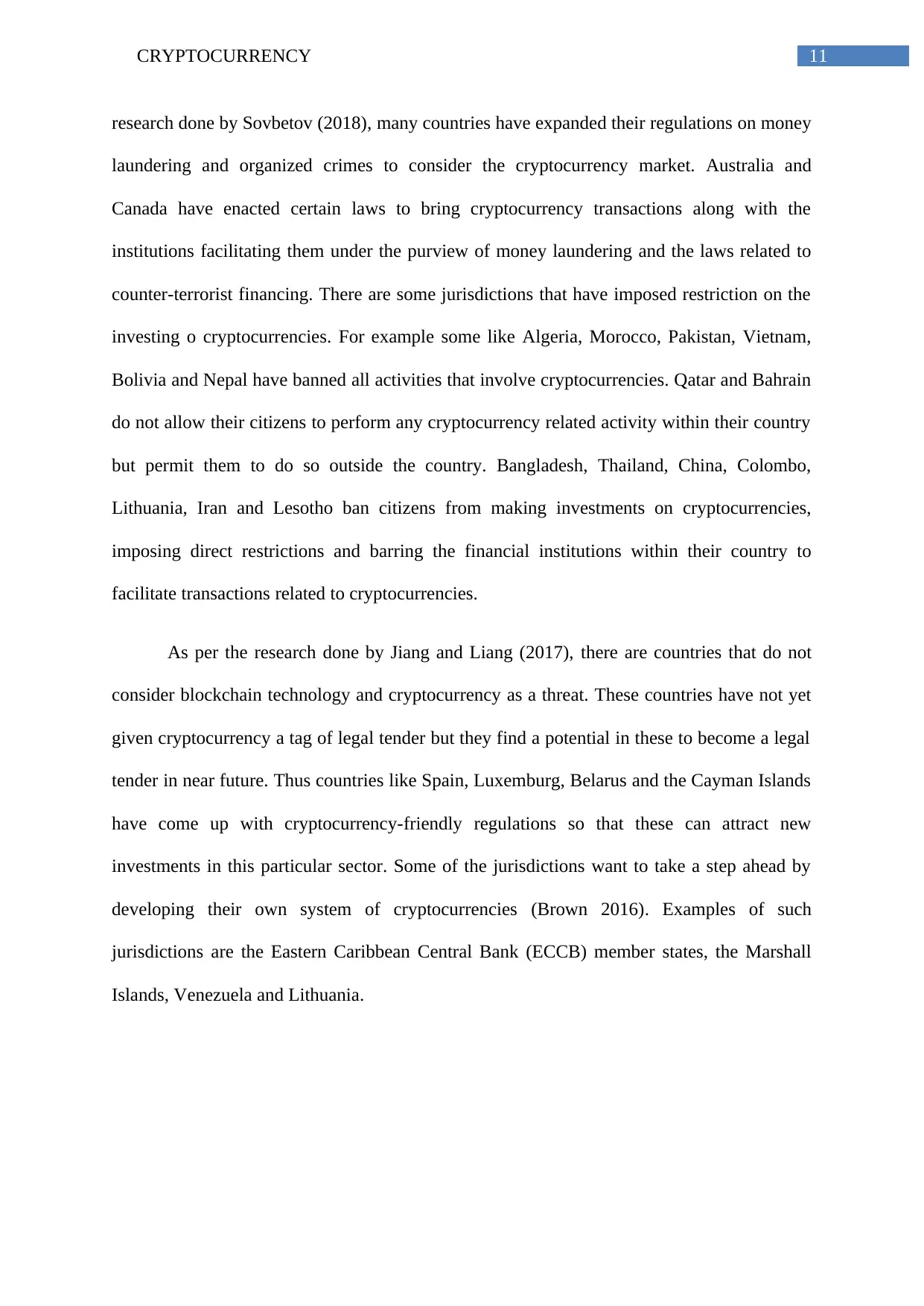
11CRYPTOCURRENCY
research done by Sovbetov (2018), many countries have expanded their regulations on money
laundering and organized crimes to consider the cryptocurrency market. Australia and
Canada have enacted certain laws to bring cryptocurrency transactions along with the
institutions facilitating them under the purview of money laundering and the laws related to
counter-terrorist financing. There are some jurisdictions that have imposed restriction on the
investing o cryptocurrencies. For example some like Algeria, Morocco, Pakistan, Vietnam,
Bolivia and Nepal have banned all activities that involve cryptocurrencies. Qatar and Bahrain
do not allow their citizens to perform any cryptocurrency related activity within their country
but permit them to do so outside the country. Bangladesh, Thailand, China, Colombo,
Lithuania, Iran and Lesotho ban citizens from making investments on cryptocurrencies,
imposing direct restrictions and barring the financial institutions within their country to
facilitate transactions related to cryptocurrencies.
As per the research done by Jiang and Liang (2017), there are countries that do not
consider blockchain technology and cryptocurrency as a threat. These countries have not yet
given cryptocurrency a tag of legal tender but they find a potential in these to become a legal
tender in near future. Thus countries like Spain, Luxemburg, Belarus and the Cayman Islands
have come up with cryptocurrency-friendly regulations so that these can attract new
investments in this particular sector. Some of the jurisdictions want to take a step ahead by
developing their own system of cryptocurrencies (Brown 2016). Examples of such
jurisdictions are the Eastern Caribbean Central Bank (ECCB) member states, the Marshall
Islands, Venezuela and Lithuania.
research done by Sovbetov (2018), many countries have expanded their regulations on money
laundering and organized crimes to consider the cryptocurrency market. Australia and
Canada have enacted certain laws to bring cryptocurrency transactions along with the
institutions facilitating them under the purview of money laundering and the laws related to
counter-terrorist financing. There are some jurisdictions that have imposed restriction on the
investing o cryptocurrencies. For example some like Algeria, Morocco, Pakistan, Vietnam,
Bolivia and Nepal have banned all activities that involve cryptocurrencies. Qatar and Bahrain
do not allow their citizens to perform any cryptocurrency related activity within their country
but permit them to do so outside the country. Bangladesh, Thailand, China, Colombo,
Lithuania, Iran and Lesotho ban citizens from making investments on cryptocurrencies,
imposing direct restrictions and barring the financial institutions within their country to
facilitate transactions related to cryptocurrencies.
As per the research done by Jiang and Liang (2017), there are countries that do not
consider blockchain technology and cryptocurrency as a threat. These countries have not yet
given cryptocurrency a tag of legal tender but they find a potential in these to become a legal
tender in near future. Thus countries like Spain, Luxemburg, Belarus and the Cayman Islands
have come up with cryptocurrency-friendly regulations so that these can attract new
investments in this particular sector. Some of the jurisdictions want to take a step ahead by
developing their own system of cryptocurrencies (Brown 2016). Examples of such
jurisdictions are the Eastern Caribbean Central Bank (ECCB) member states, the Marshall
Islands, Venezuela and Lithuania.
⊘ This is a preview!⊘
Do you want full access?
Subscribe today to unlock all pages.

Trusted by 1+ million students worldwide
1 out of 20
Related Documents
Your All-in-One AI-Powered Toolkit for Academic Success.
+13062052269
info@desklib.com
Available 24*7 on WhatsApp / Email
![[object Object]](/_next/static/media/star-bottom.7253800d.svg)
Unlock your academic potential
Copyright © 2020–2025 A2Z Services. All Rights Reserved. Developed and managed by ZUCOL.





